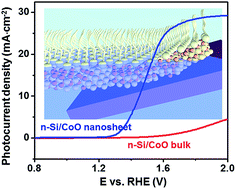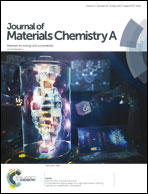Wafer-scale synthesis of ultrathin CoO nanosheets with enhanced electrochemical catalytic properties†
Abstract
Large area synthesis of two dimensional (2D) nanomaterials with a non-layered crystal structure remains a grand challenge. In this article, we report a solution-based bottom-up synthesis of wafer-scale nanometer-thick CoO nanosheets using ionic layer epitaxy (ILE). In ILE, a monolayer of ionized oleyl sulfate surfactants at the water–air interface served as a flexible template for direct CoO crystallization underneath. The as-synthesized CoO nanosheet is polycrystalline and could be grown as large as the entire solution surface in the reactor (>cm2) with a uniform 2.8 nm thickness across the entire sheet. The nanosheet is free-standing on the water surface and can be readily transported to arbitrary substrate surfaces for device fabrication. As a demonstration, centimeter-sized CoO nanosheets were directly transferred to Si wafers for electrochemical electrode applications. The nanometer thick CoO nanosheet exhibited higher catalytic properties towards the oxygen evolution reaction (OER) compared to bulk CoO. It also showed excellent stability at high photocurrent density when used as a photoelectrochemical (PEC) photoanode in corrosive alkaline electrolytes. This work evidenced the effectiveness of the ILE technique in synthesizing 2D nanomaterials from a broad range of functional oxides with enhanced physical properties.



 Please wait while we load your content...
Please wait while we load your content...